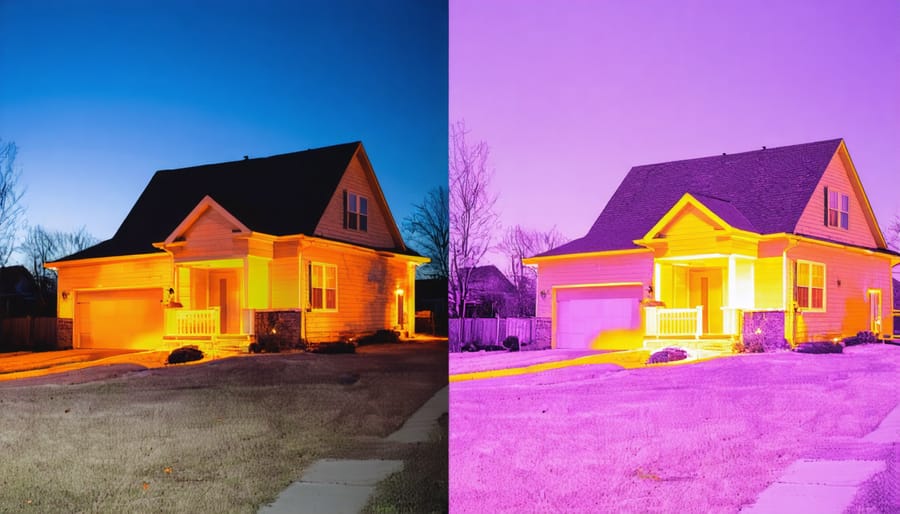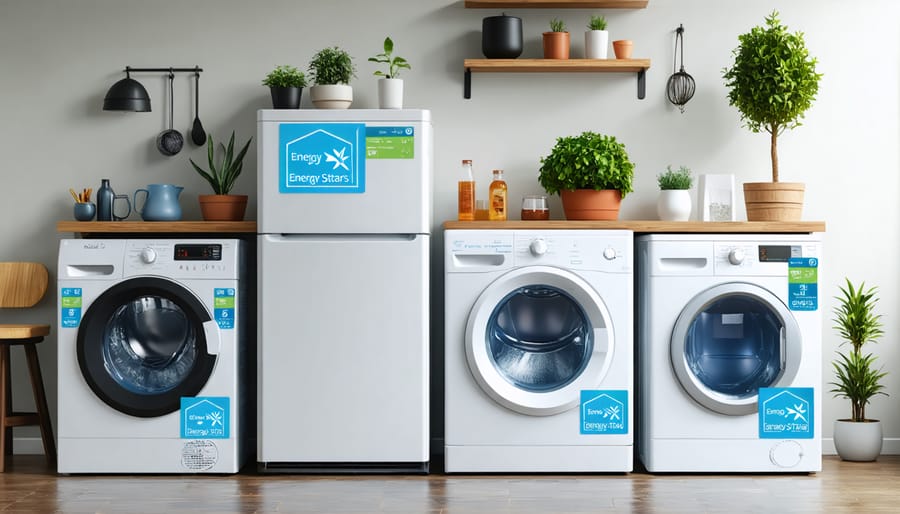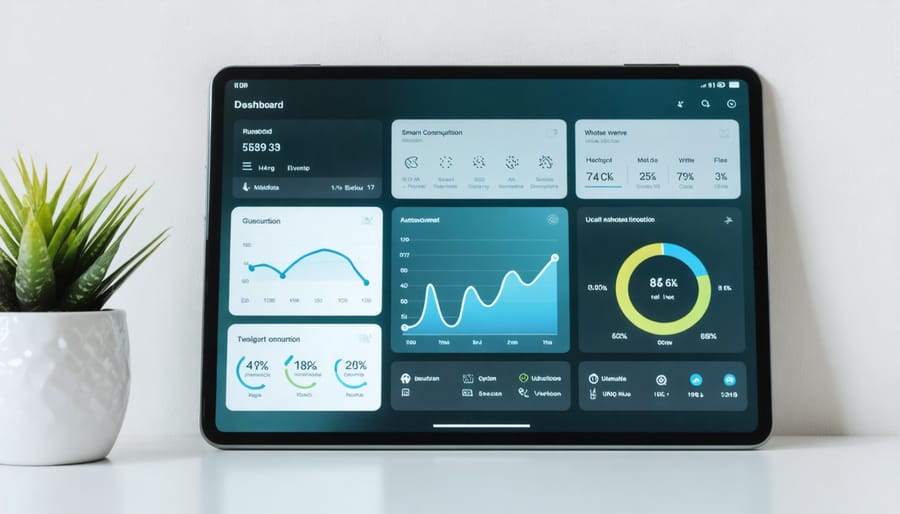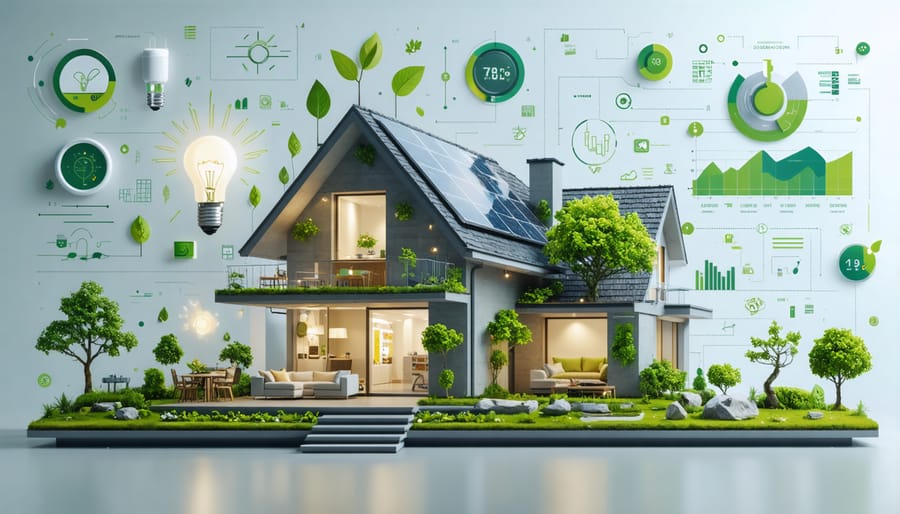Transform your home into an energy-efficient sanctuary and reduce your utility bills with strategic upgrades that deliver immediate results. Install programmable thermostats to automatically adjust temperatures, saving up to 10% annually on heating and cooling costs. Seal air leaks around windows and doors with weatherstripping to prevent expensive temperature loss, while upgrading to LED bulbs cuts lighting costs by 75% compared to traditional incandescents. Modern smart home systems integrate these efficiency measures seamlessly, monitoring real-time energy usage and optimizing consumption patterns automatically. By implementing these proven strategies, homeowners typically see significant savings within the first month while enjoying enhanced comfort and contributing to environmental sustainability.
Quick Wins for Immediate Energy Savings
Smart Thermostat Strategies
Your smart thermostat can be your best ally in the battle against high energy bills. Think of it as your home’s temperature conductor, orchestrating comfort and savings throughout the day. The key is to program it strategically around your daily routine.
Start by setting your thermostat 7-10 degrees lower (in winter) or higher (in summer) when you’re sleeping or away. For most households, that means dropping to around 62°F overnight in winter and raising to 78°F during summer days. During active hours when you’re home, aim for 68°F in winter and 75°F in summer for optimal comfort and efficiency.
Create multiple daily schedules that match your lifestyle. For instance, program your thermostat to start warming up the house 30 minutes before you wake up, then adjust to energy-saving mode once you leave for work. If you work from home, consider zone-based temperature control for occupied areas only.
Take advantage of your smart thermostat’s learning capabilities and mobile app features. Use the data insights to fine-tune your settings, and don’t forget to enable features like geofencing, which automatically adjusts temperatures based on your location. Some models even factor in local weather forecasts to optimize performance.
Remember, each degree of adjustment can impact your energy bill by about 2%, so small tweaks can lead to significant savings over time.
LED Lighting Makeover
Transforming your home’s lighting to LED technology is one of the smartest energy-efficiency upgrades you can make. Not only do LED bulbs use up to 75% less energy than traditional incandescent bulbs, but they also last up to 25 times longer, making them a brilliant investment for both your wallet and the planet.
Start by conducting a lighting audit of your home. Note which fixtures are still using old-style bulbs and prioritize replacing the most frequently used ones first. Popular spaces like the kitchen, living room, and outdoor security lights typically offer the quickest return on investment.
When selecting LED bulbs, pay attention to the color temperature. Warm white (2700-3000K) creates a cozy atmosphere perfect for living spaces, while cool white (4000-5000K) works better in task-oriented areas like home offices or garages. Many modern LED options are also dimmable, allowing you to adjust light levels throughout the day.
Consider integrating smart LED bulbs into your lighting strategy. These can be controlled via smartphone apps or voice commands, letting you create automated schedules or turn off forgotten lights remotely. Some smart bulbs even adjust their brightness and color temperature automatically to match your circadian rhythm, potentially improving your sleep patterns while saving energy.
For outdoor areas, look for LED fixtures with motion sensors or dawn-to-dusk features. These ensure lights only operate when needed, maximizing energy savings without compromising security.

Insulation and Weatherization Secrets
DIY Draft Detection
Ever wondered if your home is secretly letting precious heated or cooled air escape? Let’s turn detective with a simple DIY draft detection method that’ll help you pinpoint those sneaky air leaks around your windows and doors.
Start by gathering your tools: you’ll need a lit incense stick (or candle), a damp hand, and a notepad to mark problem areas. On a windy day, slowly move the incense stick around window frames and door edges. Watch the smoke trail – if it wavers or gets pulled in a particular direction, you’ve found a leak! The damp hand technique works similarly; you’ll feel a cool sensation where air is sneaking through.
Common trouble spots include:
– The bottom of exterior doors
– Window sashes and frames
– Where different materials meet (like wood and brick)
– Mail slots and pet doors
– Electrical outlets on exterior walls
Once you’ve identified the culprits, fixing them is surprisingly simple. For windows, apply weatherstripping tape along the frames and use rope caulk to seal gaps. Door sweeps can eliminate under-door drafts, while foam gaskets behind outlet covers tackle those sneaky wall leaks.
Pro tip: Test your fixes by repeating the incense test. If the smoke stays steady, you’ve successfully sealed that leak! For extra credit, perform this check seasonally, especially before winter sets in. A well-sealed home not only keeps you cozy but can slash your energy bills by up to 15%.
Remember, even small drafts add up – it’s like leaving a window open 24/7! Taking an hour to detect and seal these leaks is one of the most cost-effective energy improvements you can make.
Smart Insulation Upgrades
Proper insulation is the unsung hero of maximizing energy efficiency in your home. Think of insulation as your home’s cozy sweater – it keeps the warmth in during winter and the heat out during summer. The good news? You don’t need to break the bank to make significant improvements.
Start with your attic, as this is where up to 25% of your home’s heat can escape. Adding a layer of fiberglass batts or blown-in cellulose insulation can dramatically improve your home’s thermal envelope. For a weekend DIY project, focus on sealing gaps around attic hatches and installing proper weatherstripping.
Walls deserve equal attention, particularly in older homes. While adding insulation to existing walls might seem daunting, innovative solutions like blown-in insulation can be installed through small holes with minimal disruption to your living space. Consider starting with exterior walls in rooms that feel particularly drafty or uncomfortable.
Don’t overlook your crawl space – it’s a crucial area that often gets neglected. Installing rigid foam boards or spray foam insulation here not only improves energy efficiency but also helps prevent moisture issues. Pro tip: Before insulating, check for and seal any air leaks around pipes and electrical outlets.
For a smart approach to insulation, invest in an energy audit first. This will help identify your home’s specific weak points and ensure you’re targeting the right areas. Remember to pay special attention to rim joists, electrical boxes, and other often-forgotten spots where cold air can sneak in.
Finally, consider eco-friendly options like recycled denim or sheep’s wool insulation. These materials offer excellent thermal performance while being sustainable and safe to handle.

Appliance Efficiency Maximization
HVAC Optimization
Your HVAC system is like the heart of your home’s energy efficiency, and giving it some TLC can lead to significant savings. Start with the basics: replace or clean your air filters every 1-3 months. A clogged filter makes your system work harder, using more energy and potentially shortening its lifespan.
Consider installing a smart thermostat that learns your schedule and adjusts temperatures automatically. These clever devices can reduce your heating and cooling costs by up to 10-15% annually. Pro tip: set your thermostat to 78°F in summer and 68°F in winter when you’re home, adjusting by 7-10 degrees when you’re away or sleeping.
Don’t skip your annual HVAC maintenance check-ups! A professional can spot potential issues before they become costly problems and ensure your system runs at peak efficiency. Between check-ups, keep your outdoor unit clear of debris and vegetation, and vacuum your vents regularly.
Here’s a game-changer: use your ceiling fans strategically. In summer, set them to rotate counterclockwise to create a cooling breeze. In winter, reverse the direction to clockwise at a low speed to help distribute warm air that naturally rises to the ceiling.
Seal those sneaky duct leaks too – they can waste up to 30% of your conditioned air! A simple DIY check with incense can help you spot leaks around duct joints and connections.
Kitchen and Laundry Energy Savings
Your kitchen and laundry areas are hidden energy powerhouses, and a few smart habits can lead to significant savings. Start by being strategic with your dishwasher – only run it when full and skip the heat-dry setting. Instead, open the door slightly after the cycle ends and let dishes air dry naturally.
When it comes to cooking, match your pot size to the burner size for maximum efficiency. Using a 6-inch pot on an 8-inch burner wastes 40% of the heat produced! Consider using your microwave for smaller portions, as it uses far less energy than your oven.
In the laundry room, washing clothes in cold water can slash energy use by up to 90% per load. Modern detergents work just as effectively in cold water, so there’s no compromise on cleanliness. Always clean your dryer’s lint filter before each load – this simple habit improves efficiency and prevents fire hazards.
Speaking of your dryer, try using wool dryer balls instead of dryer sheets. They naturally separate clothes, reducing drying time and static while being eco-friendly. For the ultimate energy-saving move, take advantage of sunny days by hanging clothes outside to dry – you’ll get that fresh-air scent as a bonus!
Remember to maintain your appliances regularly. Clean refrigerator coils, check door seals, and keep vents clear to ensure everything runs at peak efficiency.
Smart Home Integration
Energy Monitoring Systems
Gone are the days of waiting for your monthly utility bill to understand your energy consumption. Modern energy monitoring systems empower you to monitor electricity usage in real-time, giving you unprecedented control over your home’s energy efficiency.
Smart energy monitors, which easily clip onto your electrical panel, provide detailed insights through user-friendly apps. These nifty devices break down energy consumption by appliance, helping you identify energy hogs and unusual spikes in usage. Imagine knowing exactly how much that old refrigerator costs to run or discovering that your gaming console draws significant power even in standby mode!
Popular options include the Sense Home Energy Monitor, Emporia Vue, and Ecobee SmartSensor, each offering unique features like appliance recognition, cost forecasting, and custom alerts. Many of these systems integrate seamlessly with smart home platforms, allowing you to automate energy-saving actions based on usage patterns.
The real magic happens when you start using these insights. Notice the dryer using too much power? Maybe it’s time to air-dry some clothes. Spot a mysterious energy drain at night? Those forgotten kitchen appliances might need unplugging. Best of all, many energy monitors gamify the experience, turning energy efficiency into an engaging household challenge that even kids can participate in.

Automated Energy Management
Transforming your home into a smart energy hub is easier than ever with today’s automated solutions. By implementing smart energy saving strategies, you can optimize your home’s efficiency without lifting a finger.
Start with a smart thermostat that learns your schedule and adjusts temperatures automatically. These clever devices can reduce heating and cooling costs by up to 15% by making micro-adjustments throughout the day. Many models even provide detailed energy reports and suggestions for additional savings.
Smart lighting systems are another game-changer. Motion sensors ensure lights turn off in empty rooms, while scheduling features can gradually dim lights in the evening and brighten them in the morning. Connect these to smart plugs, and you can create automated routines that power down energy-draining electronics when they’re not in use.
Consider installing a smart home hub to orchestrate all your devices. This central command center can coordinate your thermostat, lights, and appliances to work in harmony. For example, it can automatically adjust your HVAC system based on which rooms are occupied, or power down your entertainment system when you’re away.
Don’t forget about smart window blinds and curtains. These can be programmed to open and close with the sun, naturally heating your home in winter and keeping it cool in summer. Many of these devices also integrate with weather apps to optimize their settings based on real-time conditions.
Making your home more energy efficient doesn’t have to be overwhelming. By implementing even a few of the strategies we’ve discussed, you can start seeing noticeable improvements in both your energy bills and your home’s comfort level. Start with the quick wins like sealing drafts, upgrading to LED bulbs, and programming your thermostat. Then, gradually work your way up to bigger projects like improving insulation or upgrading to energy-efficient appliances.
Remember, every small change adds up to significant savings over time. Whether you’re a DIY enthusiast ready to tackle weatherstripping and insulation projects, or you prefer to focus on smart home technology and habit changes, there’s an energy-saving solution that fits your lifestyle and budget.
Take the first step today by conducting a simple home energy audit and identifying your biggest energy drains. Then, create a practical plan to address these issues one at a time. Your wallet, your comfort, and the environment will thank you for making these thoughtful improvements to your home’s energy efficiency.




